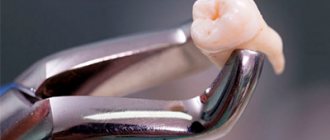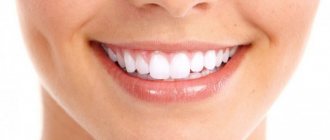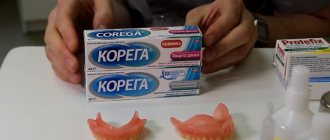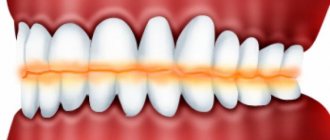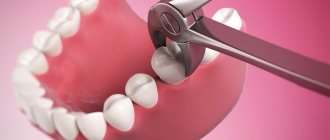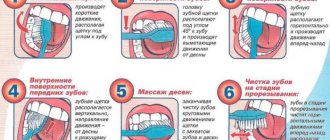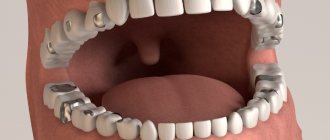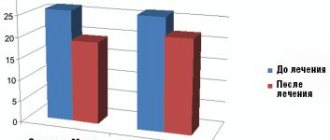Features of clasp dentures
The first clasp dentures had the shape of an arc. Even the name of this design is literally translated as “arc”. The main advantage is that the clasp denture distributes the chewing load across all supporting teeth and hard tissues of the oral cavity. But unlike removable dentures, they do not completely cover the palate or most of the gums. This means that they do not distort the sense of taste, do not affect diction, and getting used to them takes less time.
In the form of fastening on clasp dentures, a beam, locks and clasps are used. All of them do not injure tooth tissue and do not interfere with chewing or talking. In addition, their special installation ensures an aesthetically pleasing appearance while smiling.
Clasp prosthesis is partially removable. Patients can take it off in one motion and put it on just as easily. But it is worth noting that there is no particular need to remove the clasp dentures at night, as happens with removable plastic dentures. In most cases, patients remove it only to perform hygiene procedures. Due to the special type of fastening, the clasp denture will never fall off during chewing or talking, which is considered its main advantage over other dentures.
I. Relevance of the topic
One of the most important stages in the manufacture of a clasp prosthesis is the fitting of a solid-cast prosthesis frame with fixing elements to the supporting teeth. The essence of the frame fitting technique is that it is necessary to check the quality of the frame casting and determine its functional usefulness.
At the stage of checking the design of a clasp prosthesis, a significant place is occupied by determining the route of its insertion and removal. A high-quality frame of a clasp prosthesis is the key to the usefulness of the future prosthesis.
One of the final stages in clasp prosthetics is the stage of applying the prosthesis. The essence of the method is that it is necessary to give a qualitative assessment of the prosthesis, determine its functional and aesthetic value, and teach the patient how to use it correctly.
The structure of the clasp prosthesis
The main parts of a clasp denture are a metal frame, the fasteners listed above, an arch, and also a base on which artificial teeth are attached. The arch, clasps and base are responsible for fixation in the prosthesis. Support-retaining structures in clasp dentures are solid, individually cast from metal and then soldered, and also soldered wire. The choice is made purely individually depending on the number of missing teeth and the condition of the jaw.
In most cases, clasps are used. They are special hooks that hold the clasp denture on the supporting teeth:
There are several ways to make a clasp for clasp dentures:
- It is considered simple to bend the wire in accordance with the shape of the prosthesis model.
- A complex clasp is cast as a solid crown from a special alloy during the manufacture of the arch of the clasp prosthesis.
But the holding elements are divided not only according to the manufacturing method.
There are clasps:
- supporting;
- holding;
- performing these two functions at once.
The first distribute the load from the clasp denture, which occurs during talking, chewing, clenching teeth, onto the supporting teeth and partially onto the mucous membrane. In contrast, the retaining clasps of clasp dentures transfer the load to the mucous membrane, plunging into it when pressure occurs. The latter are capable of performing the functions of both the former and the latter.
All clasps consist of several parts. The clasp body of the clasp denture is located on the supporting tooth in its upper area. The clasp arm touches the side surface of the tooth. Due to the presence of an occlusal pad, the clasp prosthesis does not sink deep into the gum and does not injure it during chewing. In addition, it is able to restore the height of crowns. In addition, there is a process of the clasp or that part of it that is located in the body of the base of the clasp prosthesis.
Clasp dentures with locking fastening look and attach differently. Unlike dentures with clasps, they are completely invisible to others, because fixation is carried out by micro-locks that are located in the clasp denture system.
In this case, metal-ceramic crowns are placed on the supporting teeth, in which one part of the lock is attached. Its second part is fixed in the clasp prosthesis. During dressing, the clasps are fastened and the denture is securely held in the oral cavity and does not fall off during chewing. In this case, the load from the clasp denture falls only on the supporting teeth, so you should not use this method of fixation in cases where the teeth have mobility.
Based on the fastening methods, it remains to conclude that a clasp denture is indicated only in cases where there are supporting teeth. Without them, the clasp prosthesis will not hold.
In addition to the support system, the clasp prosthesis has a base. The teeth are attached to it. Today, prosthetics are carried out using various dental manufacturing companies. Due to this, you can achieve high aesthetics and an attractive appearance. The same applies to the plastic used for the base of the clasp prosthesis. High-quality materials have a long service life and are distinguished by their perfect resemblance to living gums and natural teeth. The price of such a prosthesis will be a little more expensive, but it will have virtually no disadvantages.
You can choose a suitable clasp prosthesis from the photo, but it is better to hold it in your hands. Therefore, only a visit to the dentist will provide comprehensive information about the clasp denture.
Scheme of the OOD on the topic: “Checking the frame of a clasp prosthesis in the clinic”
| Action steps | Means of action | Criteria and controls |
| Check all structural elements of the clasp denture frame on jaw models | ||
| 1. Prosthesis frame: - boundaries | Models of jaws with partial absence of teeth in an occluder with a clasp denture frame | The frame of the clasp prosthesis must correspond to the boundaries outlined by the doctor. The frame must be stable on the model, not balanced. |
| — location of the arc and saddles | The arch on the upper jaw is 0.5 mm apart, width 8-10 mm, thickness 0.9-1.2 mm. The arch on the lower jaw is 0.5 mm apart, width 2-3 mm, thickness 1.5-2.0 mm. Located in the middle between the necks of natural teeth and the transitional fold. There should be room for plastic under the nets. | |
| 2. Clasps: - correct manufacturing | The clasp must have a shoulder, a body, an appendage. | |
| — clarify the location of the clasp elements | ||
| - shoulders | The stabilizing part of the clasp on the abutment tooth should be located above the line of sight on the lower jaw, and below on the upper jaw. The fixing (retention) part of the clasp is located on the lower jaw below the line of sight, on the upper jaw - above | |
| - occlusal pad | Located on the chewing surface of the tooth in fissures or artificially created recesses. | |
| Checking the design of the clasp denture frame in the oral cavity | ||
| Checking the quality of the frame: - clasp | Clasp denture frame, dental mirror | The inner surface of the clasps facing the tooth should not have nicks or pores. The edges of the clasp and its ends are rounded; |
| - arcs | It must be free of foreign inclusions and pores, and have the appropriate thickness and width. | |
| Fixation of the frame on the supporting teeth in the oral cavity: - shoulders | Carefully and effortlessly fix the frame onto the supporting teeth. There is no frame balancing. They should pass the equator with little effort and tightly cover the tooth along its entire length. | |
| Occlusal pads | They should be located on the chewing surface of the abutment tooth in fissures or artificially created recesses, fit tightly and not increase the bite. | |
| - saddles | There should be enough space for the plastic. | |
| Relationship of dentition in central occlusion. | Occlusal pads should not increase the bite and interfere with the movements of the lower jaw. | |
| Identify errors if they were made and eliminate them | Copy paper | If the occlusal overlay increases the bite, then use carbon paper to determine the point of increase and grind it down. If the frame is poorly fixed, the frame does not comply with the requirements for it, the frame must be redone. |
After the stage of checking the frame of the clasp prosthesis, the technician sets up the teeth and then follows the subsequent clinical stage of manufacturing the clasp dentures “Checking the design of the clasp denture”.
Scheme of the OOD on the topic: “Checking the design of the clasp prosthesis”
| Action steps | Means and instruments of action | Criteria and means of self-control |
| Check all structural elements of the clasp denture on jaw models | ||
| Prosthesis base: - tight fit of the base to the prosthesis | Models of jaws with partial absence of dentition in an occluder with a wax composition of a clasp denture | The base of the prosthesis should not balance on the model or fit tightly to the alveolar process; |
| - boundaries | Must coincide with the boundaries marked by the doctor. The base must correctly follow the contours of the prosthetic bed. There should be no pores or cracks. Defects in plaster models. | |
| Clasps: - specify the location of the clasp elements | All elements of the clasp prosthesis must correspond to the boundaries recommended by the doctor. | |
| - shoulders | On the abutment tooth, the fixing part of the clasp is located in a niche, between the line of sight and the neck of the tooth. | |
| - occlusal pad | Located in fissures or artificially created depressions. | |
| Arrangement of artificial teeth: -relationship with antagonist teeth | Dense multiple contact of all teeth (fissure-tubercular closure in the area of chewing teeth) | |
| - the shape of the relationship of the dentition (bite) | Depends on the bite or relationship of the alveolar processes of the patient’s jaw | |
| - the position of each tooth to the alveolar process | The vertical axis of each tooth must correspond to the middle of the alveolar process | |
| The position of each tooth to the rows of standing teeth | There must be close contact between natural and artificial teeth. | |
| Check the design of the prosthesis in the oral cavity | ||
| The correct position of the clasps on the supporting teeth | Frame of a clasp prosthesis with a wax base composition, a set of instruments for examining the patient | No balancing of the prosthesis, good fixation, the clasps tightly cover the teeth. |
| - occlusal pad | Located in fissures or artificially created depressions, tightly adjacent to the surface of the tooth; | |
| - bite arc | It is spaced from the mucous membrane on the upper jaw by 0.5 mm, on the lower jaw, depending on the shape of the slope of the oral surface of the alveolar process, by 0.5-1.5 mm. | |
| Tightness of fit to the prosthetic bed | Dental mirror | The edge of the base along the periphery should fit tightly to the mucous membrane of the prosthetic bed; there is no balance of the base. |
| Clarify the boundaries of the basis | The base must follow the contours of the prosthetic bed (indicated by the doctor). | |
| Relationship of dentition in central occlusion | Dental spatula | Tight closure of teeth throughout |
| Check the height of the lower part of the face with teeth closed | Tight closure of natural and artificial teeth (no gap between natural teeth). | |
| Check compliance with aesthetic guidelines for teeth placement: - shape and color of teeth | Must match remaining natural teeth | |
| Check phonetically for the correct placement of the arcs: lower arc, upper arc | When speaking, it should not interfere with the movement of the tongue. | |
| Identify errors if they were made at the stage of determining the central relationship of the jaws and eliminate them | Disorders of teeth closure. Eliminate them in the clinic, assign the patient to re-check the design of the prostheses. |
SITUATIONAL TASKS
1. When checking the frame of the arched prosthesis for the upper jaw, the following was discovered: the clasps are correctly positioned on the supporting teeth, tightly covering them. The frame is easily inserted into the oral cavity, is well fixed, does not balance and does not interfere with occlusion. The distance between the arch and the mucous membrane is 2.5-3 mm.
Identify the error identified during the frame design verification phase
clasp prosthesis in the clinic. How to fix it.
2. When checking the frame of the arched prosthesis, the patient was found to have weak fixation of the support-retaining clasp on the abutment tooth.
The doctor's tactics in this situation.
3. When applying the frame of the clasp denture to the patient’s upper jaw, it was revealed that the saddle-shaped part and the arch of the denture frame fit tightly to the mucous membrane of the prosthetic bed throughout its entire length.
What is the identified flaw in the frame?
Ways to eliminate it.
4. When checking the frame of the clasp denture, an overestimation of the patient’s bite was revealed - separation of the dentition in the frontal region by 2-3 mm. What is the reason for the separation of the dentition. What is the doctor's tactics?
5. The patient has partial secondary adentia. When checking the frame of the clasp denture on the upper jaw, it was revealed that it was balancing. Outline possible reasons for frame balancing and suggest methods for eliminating them.
LITERATURE
1. Lecture material.
8. Gavrilov E.I., Shcherbakov A.S. Orthopedic dentistry. M., 1984
9. Kurlyandsky V.Yu. Orthopedic dentistry. 1974
10. Kopeikin V.N. Orthopedic dentistry.1986
11. Kopeikin V.N., Damper L.M. Dental technology. 1985
12. Kurlyandsky V.Yu. Guide to practical training in orthopedic dentistry. M., 1973
13. Orthopedic dentistry / N.G. Abolmasov [and others]. Moscow, 2007
Additional:
5. Bushan M.G. etc. Directory of orthopedic dentists. Chisinau, 1988
6. Perzashkevich L.M. Abutment dentures. M., 1974
7. Doynikov A.I., Sinitsyn V.D. Dental materials science. 1986
LESSON 16
Topic: Method of applying a clasp denture in case of partial absence of teeth. Criteria for clinical assessment of the quality of the manufactured clasp prosthesis. Rules for using prostheses.
Purpose of the lesson : to teach students the technique of applying a finished clasp denture and to be able to give instructions to the patient on the care of dentures.
QUESTIONS STUDYED PREVIOUSLY AND REQUIRED FOR THIS LESSON
- Criteria for clinical evaluation of plate prostheses.
- Rules for the use of plate prostheses.
CONTROL QUESTIONS
1. Technical requirements for the finished clasp prosthesis.
2. Rules for fitting and applying the finished clasp prosthesis and their sequence.
3. Possible causes of poor fixation of the clasp prosthesis and ways to eliminate them.
4. Errors made during the manufacture of the base of the clasp prosthesis and methods for eliminating them.
5. Rules for using clasp dentures.
LOGICAL-DIDACTICAL STRUCTURE (LDS). TOPIC: “FITTING AND OVERLAYING A CLASS PROSTHETIC. INSTRUCTION TO THE PATIENT ON THE RULES FOR PROSTHETIC USE"
| Clasp prosthesis |
| 1. Evaluation of the prosthesis outside the mouth | Clasp denture frame | Basis | Teeth |
| The frame and clasps must be smoothly polished | The outer surface is smooth, shiny, well polished. The thickness of the prosthesis base is 2-2.5 mm, the edges are rounded, the color is pale pink, uniform in color. | Correct anatomical shape, located in the dental arch, the color of artificial teeth should match the color of natural teeth |
1. Hygienic treatment of the clasp prosthesis.
2. Fitting and applying the prosthesis.
| Basis: The prosthesis is not applied to the jaw. Look for obstacles on the base using carbon paper. Base correction is carried out with a metal cutter. | Arch: The fit of the arch to the mucosa: - dense - large lumen - low at low level - normal | Teeth: Checking the closure of teeth. Artificial teeth are ground to prevent occlusal movements. | Clasps: Location on the teeth. Tight fit of the shoulders and occlusal lining to the tooth. The occlusal parts of the support-retaining clasps do not block the movements of the lower jaw. |
3. Assessment of prosthesis application.
| Basis: -easy to enter and exit; - the baseline boundaries specified by the doctor are preserved | The arc: -is located at the required distance from the mucous membrane; -on the lower jaw does not injure the frenulum of the tongue | Clasps: -fixes the prosthesis well | Teeth: -multiple contact in the position of central occlusion; -free articulation; - meet aesthetic tests |
The prosthesis meets clinical requirements.
4. Patient instruction.
| Expected difficulties: The patient feels the prosthesis as a foreign body. Speech impairment. Feeling of pressure on the mucous membrane. Profuse salivation | Feeling pain: Apply a prosthesis 3-4 hours before coming to the doctor. Correct the prosthesis. | Mode of use: Learn how to insert and remove dentures; Use only during the day. | Caring for your denture After eating, rinse your mouth; Before going to bed, wash thoroughly with a toothbrush. Possible storage methods: -dry; - in a humid environment; - in disinfectant liquid. |
Clasp dentures have a number of advantages over bridges:
- Installation of clasp removable dentures does not require preparation of some teeth and does not limit their mobility.
- Chewing pressure is evenly distributed between the alveolar processes and the remaining teeth.
- Clasp dentures are hygienic; they can be cleaned mechanically outside the oral cavity.
To individually assess the condition of your teeth and make various solutions to your problem, you need to have a free consultation with an orthopedic dentist. A highly qualified specialist will help in any of your situations.
IV. Composition of educational material
| Discipline | Know | Be able to |
| I. Initial: Anatomy Physics Chemistry Propaedeutics of orthopedic dentistry | Structure of the oral cavity Physicochemical characteristics materials for the manufacture of clasp dentures and their effect on oral tissues | Take into account the anatomical features of the oral cavity when planning the design of a clasp denture Be able to apply knowledge in practice |
Conclusion: Indications for the use of removable clasp dentures
In persons with partial absence of teeth, along with end defects, combined and included defects are often encountered. Plate and clasp removable dentures can successfully replace end defects. Clasp dentures have a number of significant advantages over removable plate dentures:
- The base part of clasp dentures is minimal.
- The arch in the prosthesis ensures uniform distribution of the load between its sides.
- The prosthesis contains supporting clasps, which allow partial transfer of the load through the tissues of the supporting teeth.
- Compared to other complete removable dentures, clasp dentures can be slightly adjusted.
- The oral mucosa and gingival papillae are partially released.
- Reliable fixation of the prosthesis speeds up adaptation.
Before introducing the frame of a clasp denture, it is necessary to visually evaluate the quality of its manufacture: The inner surface of the clasps facing the tooth should not have notches or pores, and the edges of the clasp and its ends should be rounded; the frame arc should be free of foreign inclusions and pores, and have the appropriate thickness and width. Only after this the frame of the clasp prosthesis is introduced into the oral cavity and applied in accordance with the “route of insertion”.
The frame of the clasp prosthesis must correspond to the boundaries outlined by the doctor. The frame must be stable, not balanced. The arch on the upper jaw is 0.5 mm apart, width 8-10 mm, thickness 0.9-1.2 mm. The arch on the lower jaw is 0.5 mm apart, width 2-3 mm, thickness 1.5-2.0 mm. Located in the middle between the necks of natural teeth and the transitional fold. There should be room for plastic under the nets. The clasp must have a shoulder, a body, an appendage. The stabilizing part of the clasp on the abutment tooth should be located above the line of sight on the lower jaw, and below on the upper jaw. The fixing (retention) part of the clasp is located on the lower jaw below the line of sight, on the upper jaw - above. The occlusal pad is located on the chewing surface of the tooth in fissures or artificially created recesses.
Check the fixation of the frame on the supporting teeth in the oral cavity: carefully fix the frame on the supporting teeth without effort; there should be no balancing of the frame in the anteroposterior and lateral directions.
The arms of the clasps should pass the equator with little effort and tightly cover the tooth along its entire length. Occlusal pads should be located on the chewing surface of the abutment tooth in fissures or artificially created recesses, fit tightly and not increase the bite. Saddles must have enough space for plastic.
Next, it is necessary to check and clarify the occlusal relationships in all phases of all types of occlusion: occlusal overlays should not increase the bite and interfere with the movements of the lower jaw. If the occlusal overlay increases the bite, then using carbon paper, determine the point of increase and grind it or the antagonist (within the enamel), and if this is not possible, the prosthesis must be remade.
If the frame of the prosthesis on the model meets all the requirements, and checking it in the mouth reveals any shortcomings (balance of the prosthesis, loose fit of the clasps, tight fit of the arch (clasp) to the mucous membrane), re-analyze the frame on the model, check the integrity of the plaster on the supporting teeth . In case of minor errors, clinical fitting is carried out using carbon paper, sanding off small sections of the frame or bending it with crampon tongs. The frame should not be excessively thinned during grinding, as this will lead to further failure. If the frame is poorly fixed or the frame does not meet the requirements for it, the frame must be redone.
Then the doctor, together with the patient, selects the color and style of artificial teeth. After which the dental technician begins to make a saddle-shaped part from wax and install artificial teeth; replacing wax with plastic, polymerization and processing of plastic. The final stage is the fitting and application of the clasp denture in the oral cavity, recommendations and appointment of the patient for correction.
Clinical stage of testing the clasp prosthesis.
Checking the clasp denture begins with assessing the wax composition on models of the jaws in the occluder. The base of the prosthesis should not balance on the model, but should fit tightly to the alveolar process. The boundaries of the prosthesis must coincide with the boundaries marked by the doctor. The base must correctly follow the contours of the prosthetic bed. There should be no pores, cracks, or defects in the plaster models. The arch of the clasp denture is spaced from the mucous membrane on the upper jaw by 0.5 mm, on the lower jaw, depending on the shape of the slope of the oral surface of the alveolar process, by 0.5-1.5 mm. All elements of the clasp prosthesis must correspond to the boundaries recommended by the doctor. On the abutment tooth, the fixing part of the clasp is located in a niche, between the line of sight and the neck of the tooth. The occlusal pad is located in fissures or artificially created recesses.
Next, it is necessary to check the placement of artificial teeth in relation to the teeth preserved in the mouth, antagonist teeth, the crest of the alveolar process, the depth of overlap, and the density of contact during movement of the lower jaw. There must be dense multiple contact of all teeth (fissure-tubercular closure in the area of chewing teeth). The shape of the relationship of the dentition (occlusion) is checked, which depends on the bite or the relationship of the alveolar processes of the patient’s jaw. The position of each tooth in relation to the alveolar process is assessed: the vertical axis of each tooth should correspond to the middle of the alveolar process. There must be close contact between natural and artificial teeth. The phonetic correctness of the position of the arch of the clasp prosthesis of the lower jaw is checked: when speaking, it should not interfere with the movement of the tongue.
Together with the patient, they check the aesthetics of the prosthesis: color, shape, size, placement of artificial teeth, making appropriate adjustments if necessary. At this stage, the correct isolation of the torus and exostoses is checked, and the color of the base plastic is selected.
If errors were made at the stage of determining the central relationship of the jaws (impaired closure of the teeth), identify them and correct them in the clinic and laboratory, and assign the patient to re-check the design of the dentures.
Clinical stage of fitting and applying a clasp prosthesis.
When fitting the finished prosthesis in the patient’s mouth, the quality of polymerization of the base plastic is first visually monitored. They also check the quality of polishing of the plastic and the thoroughness of cleaning the inner surface of the base. The presence of pores, cavities, marbling, cracks and other defects is an indicator for re-manufacturing of dentures. The clasp prosthesis is fitted using carbon paper. The points of premature contact of the plastic of the prosthesis are ground off without affecting the areas of the frame.
The fitting of a partial denture can be carried out using a correction indicator spray, such as Quickcheck (Fig. 1), which allows the doctor and technician to accurately identify areas of unwanted contact and high spots on all dentures.
Rice. 1. Quickcheck indicator spray
The principle of working with the indicator spray at the fitting stage:
1. A thin layer of spray is applied to the prosthesis frame.
2. Adjust the frame and remove it to identify contact points. 3. Grind away areas of unwanted contact.
The operation is repeated the required number of times until the frame or finished clasp prosthesis fits perfectly.
Quickcheck Spray has been designed to prevent clogging and ensure a free and smooth spray on the model. Using Quickcheck spray minimizes the chance of rework and saves time, labor and money compared to other products.
Determination of contacts on occlusal surfaces with an indicator spray:
1. Apply a thin layer of spray to the occlusal surface.
2. Carefully close the bite without lateral shifts.
3. The spray marks unwanted contacts on the inclined surfaces of the models when they are completely closed in the bite, which are ground off.
The clasp prosthesis after fitting should be freely inserted according to the “chosen path”; the clasps tightly cover the teeth; when pressing on artificial teeth in different places of the base, the prosthesis does not move or balance; the prosthesis evenly adheres to the oral mucosa.
Much attention is paid to the thoroughness of the occlusal fit of the clasp denture: the closure of all teeth in the central occlusion (natural and artificial) occurs simultaneously; there are no premature occlusal contacts, the lower jaw makes smooth articulatory movements. However, it should be borne in mind that in patients using removable dentures for the first time, the final occlusal correction should be carried out the next day after application of the prosthesis due to the inevitable “settling of the prosthesis” into the mucous membrane.
All aesthetic factors must be taken into account: color, shape, size, number of teeth.
In conversations with patients, recommendations should be especially noted: removable dentures should be kept out of the reach of pets, in perfect cleanliness without traces of plaque deposits or food residues, and should be cleaned or rinsed after each meal; Boiling dentures is unacceptable; it is advisable to store them in an aquatic environment, using a special Denta vessel with an antiseptic elixir, produced by the domestic industry and freely sold through the pharmacy chain.
Due to the fact that the application of dentures is almost always accompanied by a violation of the formation of sounds and the clarity of their pronunciation due to the disappearance of the usual articulatory points of contact between the tongue and lips, the patient should be advised to talk or read aloud more.
There is no consensus among experts regarding the need to remove removable dentures during night sleep. On the one hand, removing removable dentures at night in cases where there are single remaining teeth in the mouth with damaged supporting apparatus can lead to their injury and subsequent rapid loss. On the other hand, constant compression of the vessels of the submucosal layer by the base of the prosthesis can lead to deterioration of tissue trophism and increased atrophic processes. Therefore, in each specific case, the doctor must choose the most optimal option for the patient.
Do not remove the denture while talking or eating, do not bend the clasp yourself and do not file down the plastic. If your dentures cause pain, you should consult a doctor. 2-3 hours before coming to the doctor, dentures should be applied so that the cause of the pain is visible.
The process of adaptation to the prosthesis occurs gradually and is expressed in the restoration of impaired functions of speech, chewing, and swallowing. The perception of the prosthesis as a foreign body disappears as the patient becomes accustomed and fully adapts to it. The moment of onset of adaptation to prostheses can be considered as a manifestation of cortical inhibition, which occurs at different times depending on many reasons, varying within 30 days. According to V.Yu. Kurlyandsky (1958), the timing of a patient’s adaptation to prostheses is influenced by the degree of fixation and stabilization of the prosthesis, the presence or absence of pain, design features of the prostheses, etc. With timely re-prosthetics, the adaptation time is significantly reduced (up to 3-5 days). Of great importance in the patient’s adaptation to prostheses are the correct psychological preparation of the patient, his awareness of the need to use a prosthesis as a therapeutic agent aimed at preserving his health. He should also know that the effectiveness of prosthetics depends not only on the quality of the prostheses themselves, but also, to a certain extent, on his desire to master them, and therefore on the patient’s awareness of certain difficulties associated with getting used to the prostheses, on his patience and desire for them. overcome.
There are 3 phases of adaptation to dentures .
Phase I - irritation phase. It is observed on the day of fixation of the clasp denture in the patient’s oral cavity.
Phase II - partial inhibition. Salivation returns to normal, clarity of speech is restored, nausea disappears, and chewing efficiency increases. This period is short and takes 2-3 days.
Phase III is the phase of complete inhibition. It begins from the moment when the patient ceases to feel the prosthesis as a foreign body. Chewability is maximum. This period, depending on the type of nervous activity, lasts 1-2 weeks. When you stop using the prosthesis for a long time, a reverse reaction occurs and the adaptation process is repeated, but goes faster.
For faster adaptation of patients to clasp dentures, it is recommended not to take them out at night for 3-4 days, guided by a hygienic approach.
After the application of a removable denture, subsequent adjustments are required in most cases. This is due to varying degrees of compliance of the mucous membrane of the prosthetic bed and the inability to fully take this factor into account when designing removable dentures. Each physician must skillfully carry out these additional steps.
Caring for a clasp denture
As already mentioned, the clasp prosthesis does not need to be removed at night. You can wash it in the morning after sleeping and in the evening after eating using a toothbrush. There are many products for caring for dentures, including rinses. The doctor can explain to you how they work and help you choose based on the materials of the clasp prosthesis.
Clasp dentures are not suitable for everyone. The condition of the teeth is important, as well as the general reaction to the materials from which the prosthesis is made. However, here too experts have found a way out, using a special type of plastic that does not cause allergies. The cost of such a clasp prosthesis will be a couple of thousand rubles more than a simple one, but you will be able to use it with great pleasure.
No patient can choose a denture option on their own. Only the dentist will determine the condition of the jaw and supporting teeth, and also select the type of clasp denture.
All you have to do is make an appointment with a dentist at our center and receive all the comprehensive information from him. Once you understand what a clasp prosthesis is, we are confident that you will give us a positive review, like many others.
Advantages and disadvantages of using clasp dentures
Benefits of prosthetics
The main advantages and advantages of clasp prosthetics are:
- durability, reliability and strength of prostheses;
- tenacity of fastening the clasp in the oral cavity;
- the ability to perform prosthetics even if there are only a few teeth in the dentition;
- ease of care for the prosthesis;
- the ability not to remove the clasp at night;
- no discomfort, impaired diction, or inconvenience when eating.
Test with answers on the topic “Preparation for clasp prosthetics”
- home
- Tests
- Test with answers on the topic “Preparation for clasp prosthetics”
If you have an allergic reaction to the cobalt-chromium base of the clasp prosthesis, it can be avoided by replacing the cobalt-chrome with a gold alloy.
- for free
- clasp
- medical
- nmo
- answers
- Preparation
- prosthetics
- topic
- Test
If you have an allergic reaction to the cobalt-chromium base of the clasp prosthesis, it can be avoided by replacing the cobalt-chrome with a gold alloy.
1. The clasp denture transmits chewing pressure to
1) temporomandibular joint; 2) mucous membrane of the oral cavity and natural teeth; + 3) masticatory muscles; 4) natural teeth.
2. The retention properties of the clasp denture are determined by the presence of:
1) metal arc; 2) support-retaining clasps; + 3) occlusal pads; 4) saddle-shaped part.
3. The patient came for clasp prosthetics with teeth covered with intense soft plaque. There is a post-extraction hole with unhealed bleeding areas. Is it possible to perform Air-Flow sanitation on the patient in this case?
1) contraindicated; + 2) possible under slight pressure; 3) it is possible by taking a receipt about the possible consequences; 4) it is possible by isolating the hole.
4. Trigeminal neuralgia may be a contraindication to clasp prosthetics for
1) suspicion of neuralgia in a patient; 2) the presence of frequent attacks; 3) the presence of a pain zone in the area of the prosthesis bed; + 4) the presence of a certificate of diagnosis of “trigeminal neuralgia”.
5. In a patient with a clasp prosthesis, clasp retention has decreased. What should an orthopedic doctor do?
1) advise the patient to bend the clasps himself; 2) bend the clasps; 3) advise the use of prosthetic adhesives; 4) take an impression and send it to the laboratory along with the old prosthesis.+
6. A patient, a parachutist by profession, came to the clinic for clasp prosthetics. What type of clasp prosthesis would you recommend to him?
1) using double-arm clasps; 2) with fastenings on Acker clasps; 3) with fastenings on Roach clasps; 4) with prostheses on locking fastenings MK-1.+
7. Is a patient’s state of moderate alcoholic intoxication a contraindication to clasp prosthetics?
1) strictly contraindicated; 2) at the discretion of the dentist; + 3) is not; 4) depends on the concentration of alcohol in the exhaled air.
8. Is it possible to use locking fastenings on a clasp prosthesis with parkinsonism?
1) contraindicated;+ 2) with the consent of the patient; 3) possible in all cases; 4) only after instructing the patient.
9. The patient has a pronounced decrease in vision by OS=0.1 OD=0.3. Is it possible for him to have a clasp prosthesis with MK-1 locking fasteners?
1) it is possible by obliging relatives to monitor the process of removal and installation of the prosthesis; 2) possible, taking into account the wishes of the patient; 3) this is strictly contraindicated; + 4) this is a direct indication for installation.
10. Minimum number of teeth for clasp prosthetics:
1) 1-2 teeth; 2) 10-12 teeth; 3) 5-6 teeth; + 4) 3-4 teeth.
11. Clasp prosthesis refers to
1) hinged prostheses; 2) complete removable dentures; 3) bridges; 4) partial removable dentures.+
12. If the patient has an allergic reaction to the metals of the prosthesis, it is necessary:
1) make Quadrotti clasp prostheses from Dental-D plastic;+ 2) replace standard alloys with noble metals; 3) cover the base of the prosthesis with silicone; 4) use titanium nitride spraying on the prosthesis.
13. A patient who came for clasp prosthetics has a pale and thinned oral mucosa. What pharmacological preparation will you prescribe?
1) anticoagulants and antiplatelet agents under the control of coagulation; 2) adhesive plates with vasodilators for the future prosthetic bed; + 3) oral vasodilators; 4) regenerating gels on the area of the prosthetic bed;+ 5) antibacterial treatment.+
14. Panoramic radiography of both jaws before clasp prosthetics is needed for
1) to identify the remaining roots in the alveolar process under the future basis of the prosthesis; + 2) psychological preparation of the patient; 3) to determine the depth of bite; 4) for documentary justification of prosthetics.
15. A patient in the first trimester of pregnancy with tilted abutment teeth came for clasp prosthetics. Actions of an orthopedic dentist?
1) advise temporary prosthetics with metal-free clasp prostheses; + 2) perform preparation for metal-ceramics and depulpation without anesthesia to eliminate the negative effect of medications on the fetus; 3) use articaine anesthetics without vasoconstrictor components; 4) advise to use prosthetics after childbirth.+
16. Premedication of the patient for clasp prosthetics:
1) premedication to reduce salivation; 2) anesthesia of the oral cavity during tooth preparation;+ 3) sedative therapy;+ 4) antihypertensive therapy if necessary.+
17. A patient with a high degree of internal, situational anxiety and suspiciousness came for clasp prosthetics. Actions of an orthopedic doctor?
1) cheer up the patient, tell a joke;+ 2) turn on the radio;+ 3) turn on the aromatherapy unit (if available);+ 4) begin to empathize, sympathize.+
18. During long-term therapy for arterial hypertension with diuretics, the patient developed dry mouth. Tactics of a dentist for clasp prosthetics:
1) advise to correct diuretic therapy and come another time; + 2) advise to use traditional acrylic prosthetics; 3) treat the patient with prosthetics as an ordinary patient with recommendations for moisturizing the mucous membrane; + 4) refuse prosthetics, since dry mouth is a contraindication.
19. What psychological guidelines are best given to a patient with diabetes mellitus during clasp prosthetics?
1) for a good and long-term outcome of prosthetics; 2) for possible loosening of the supporting teeth under the clasps; 3) for frequent visits to the doctor for relining and correction of clasps;+ 4) for the orientation of replacing the prosthesis in the medium term;+ 5) for the difficulties of clasp prosthetics in a given subject.+
20. Pale, thinned mucous membrane under the future base of the prosthesis indicates
1) insufficient calorie intake of the patient; 2) the presence of dishormonal processes in the body; 3) muscle spasm of the masticatory muscles; 4) decrease in arterial blood flow.+
21. A patient with severe amnesia came on the advice of relatives for clasp prosthetics. Tactics of the orthopedic surgeon in this case
1) begin preparation for prosthetics as with an ordinary patient; 2) advise the patient to tie the prosthesis to his arm; 3) advise relatives to constantly monitor where the patient places the prosthesis; 4) advise another method of restoring the dentition.+
22. At what age can a clasp prosthesis be installed?
1) at 20-40 years old; 2) over 70 years; 3) 40-60 years; 4) in any.+
23. If you have an allergic reaction to the cobalt-chromium base of a clasp prosthesis, you can avoid it by:
1) taking desensitizing drugs; 2) identifying the cause of the body’s allergic reaction; 3) replacing cobalt-chrome with nickel-chrome; 4) replacing cobalt-chrome with a gold alloy.+
24. What to do when choosing abutment teeth for attaching clasps of a partial denture that have different inclinations?
1) expand the clasp coverage; 2) prepare teeth for a standard crown; 3) prepare the tooth for a crown with undercuts for a clasp, made using a parallelometer; + 4) limit yourself to only occlusal overlays.
25. What drugs are advisable to use for anesthesia when preparing abutment teeth?
1) articaine drugs;+ 2) lidocaine solution 2%;+ 3) procaine solution 0.5%; 4) procaine solution 2%.+
26. Clinical equator is
1) the narrowest part of the tooth; 2) the most convex part of the tooth when it is tilted; + 3) the widest part of the tooth.
27. Long-term cause of complete failure of the clasp prosthesis in diabetes mellitus:
1) abrasion of teeth in the saddle-shaped part of the prosthesis; 2) metal fatigue; 3) loss of supporting teeth in the patient; + 4) reaction of the mucous membrane to metal.
28. A patient with stents after a recent heart attack. What drugs make sense to use for anesthesia during dental preparation?
1) articaine-type drugs without adrenaline; + 2) articaine-type drugs with adrenaline; 3) lidocaine solution 2%;+ 4) procaine solution 2%.+
29. A clasp prosthesis can be used as a splinting structure for
1) dentoalveolar advancement; 2) tooth mobility of 1-2 degrees; + 3) gum recession; 4) degree 3 tooth mobility.
30. Absolute contraindication to clasp prosthetics:
1) the presence of periodontal disease; 2) diabetes mellitus; 3) caries; 4) active form of inflammation in the oral cavity.+
Dear users!
If you want to thank the author for his backbreaking work, the knowledge gained and a unique resource, you can send a DONAT
(modest to generous amount).
Thank you for being with us!
← Test with answers on the topic “Organization of medical care for victims of fires in medical institutions” ↑ Tests Test with answers on the topic “Coronavirus infection COVID-19: clinical picture, diagnosis, treatment and prevention” →
